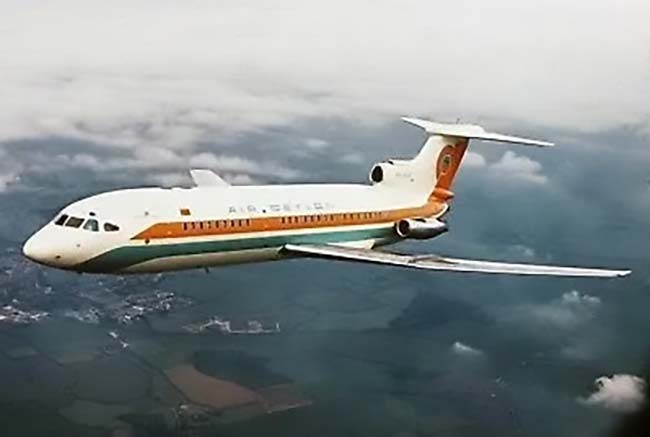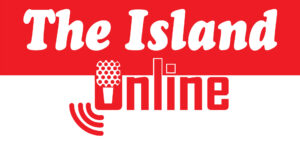OPINION
My aviation mystery

A file picture of an Air Ceylon plane. (Twitter)
By Dr Upul Wijayawardhana
Before I get to the worst experience in my air travels, I need to mention that much has happened since I wrote “Biggest mysteries in aviation history” (The Island, 22 March) which concluded with the following:
“Ten million passengers take to air each day and air travel has become the safest mode of transport but some recent incidents involving Boeing have made dents in public confidence as some are accusing Boeing of putting profits before safety. Hope it is not true!”
Based on this comment, Guwan Seeya had written an excellent piece “Truth about air safety” (The Island, 8 April) which was very revealing and concerning, as he ends his piece with: “Yes, it is a mercenary world and we are all walking on thin ice.” Considering the detailed analysis, it is pretty obvious that Guwan Seeya is an experienced pilot, most likely retired as he calls himself Seeya, who is an air-crash investigator and what he states should be taken very seriously. May I thank him wholeheartedly for the excellent information which has further evinced my interest in aviation safety.
In the practice of my profession, medicine, very quick decisions have to be made, just like in aviation, and sometimes we get things wrong. In UK, we do regular audits and review deaths so that we may improve practice by learning lessons from mistakes and have always looked up to air-crash investigations as the model to follow but even that can be improved, as pointed out by Guwan Seeya. He faults the US Federal Aviation administration (FAA) for being reactive than proactive, the most telling line in his piece being “Pilots always say there has to be blood on the runway for changes to happen!”
Boeing, once a byword for safety, has lately suffered from safety issues as it seems to have put profits first, as alluded to in my piece. It has had a downhill course since the merger in 1997 with McDonnel Douglas, ill-advised according to critics, culminating in 737Max disasters. Attempts were made to blame the pilots for the problems with the ‘Manoeuvring Characteristics Augmentation System’ resulting in the fatal crashes of Indonesia’s Lion Air and Ethiopian Airlines but Boeing had to finally admit responsibility.
Not putting bolts in a door plug, making it fly away from an Alaskan Airlines 737Max flight, however, was the turning point leading to two inquiries by the US senate where devastating evidence had been given by whistleblowers. More worryingly, one of them died of gun-shot injuries; supposed to be a suicide but some doubt whether it is so! Most of the top executives have been sacked or decided to step down and do hope a safer era of aviation would dawn. Till then, some concerned passengers may decide to opt for Airbus flights. There is some hope for SriLankan Airlines!
I have enjoyed flying and the only regret in my life is not being able to get time-off from my professional duties to obtain a private pilot’s licence. Even the warnings from Guwan Seeya is unlikely to put me off from flying! My first long-haul flight to London in 1969 was on a Vicker’s VC10, leased to Air Ceylon from BOAC and well remember rehearsing for it by taking a Colombo/Trincomalee flight, paying for it by using the first-class railway warrant!
Since then, I have been fortunate to fly all over the world on many airlines, some now extinct, meeting every eventuality except an air-crash or hijack. Our flag carrier was Air Ceylon from 1947 to 1978 and it had the distinction of never having had a major disaster. Air Lanka, which took over from Air Ceylon in September 1979 was not so lucky, one of its’ Lockheed Tristar’s being blown to two pieces by a Tiger bomb on 3rd May 1986 in BIA.
The bomb planted in the cargo hold was meant to detonate mid-air but it was fortunate that the flight was delayed resulting in the loss of only 14 lives. It was re-branded in 1998 as SriLankan Airlines and a pre-dawn raid by Tigers on 24th July 2001 resulted in the total loss of two Airbus A330 and one each of A340 and A320 aircraft.
“Ladies and gentlemen! This is the captain speaking. I am sorry to inform you that we have to make an unscheduled diversion to Bombay airport” I was woken up from a slumber by this unexpected announcement in the Air Lanka Tristar night flight headed to Dubai. I cannot remember the exact date but it was late 1986 and I was on my way to London, accompanying my good friend Dr Nihal Perera for cardiac investigations with a view to surgery. Though I am usually awake when I accompany a patient, I dozed -off after the heavy meal as Nihal’s wife Rani, who was seated just behind us, told me she would wake me up if there was any problem.
As I was a frequent traveller, many of the staff knew me and I had the occasional privilege of sitting in the cockpit too, being in the times before restrictions were introduced. I quietly approached the chief purser who confided in me that the diversion was due to a bomb-threat. When we landed in Bombay airport, I noticed the entire surroundings of the runway cleared and our flight was directed to a corner where a number of ambulances and fire-trucks were awaiting our arrival, with flashing lights! It was only then I told Nihal, whom we affectionately referred to as Seba, what the problem was and whispered “Seba, we can not wait for a wheel chair in the face of this threat. Shall we walk slowly to the terminal?” Fearing for dear life, he agreed and we hurried up with no problems, fortunately.
We were in Bombay for almost twelve hours, emplaning and getting out, at least five times as there were a number of minor irregularities. Different authorities involved made repeated checks and no bomb was found. Waiting in the then primitive Bombay airport and the apprehension was intolerable, to say the least, but were relieved when the captain made an announcement on the sixth occasion we emplaned “Ladies and Gentleman, Extremely sorry for the delay and we will be leaving shortly though the officials now say that they have overlooked searching the perishable cargo. I have decided to dump the perishable cargo, though it is worth about 15,000 British Pounds, as I do not want to inconvenience you any longer”. Deservedly, he got a thundering applause. It is so bad of me not to remember the name of that captain!
We arrived in London, exhausted and 12 hours late but Nihal was able to have tests a day later and successful surgery thereafter. He survived not only a heart attack but also this ordeal to become the President of SLMA in 1988.
Obviously, this was a hoax telephone call and extremely unlikely Tigers were behind as they mean business. I searched the website of the Department of Civil Aviation and this incident is not recorded, at all! I wonder whether Air Lanka investigated the source of the call.
This was the time GMOA was agitating for a division of the Cardiology Unit and hurling mud at me, every turn. Just imagine if Nihal got adversely affected by this hoax. My reputation would be in tatters!
What is intriguing was a news item I spotted on the front page of the early edition of the Daily News, handed to us by the cabin crew, as we sat down after emplaning in BIA. It was titled “Dr Upul Wijayawardhana off to London” and continued to say that I was accompanying Dr Nihal Perera for treatment. When I showed this to Nihal and Rani, they were as surprised as I was as neither I, nor them, had informed anyone of the visit, let alone the press! Anyway, is it newsworthy? Why was Nihal’s privacy not respected? Who gave the information and was the hoax call connected?
I can only guess but mystery remains!

